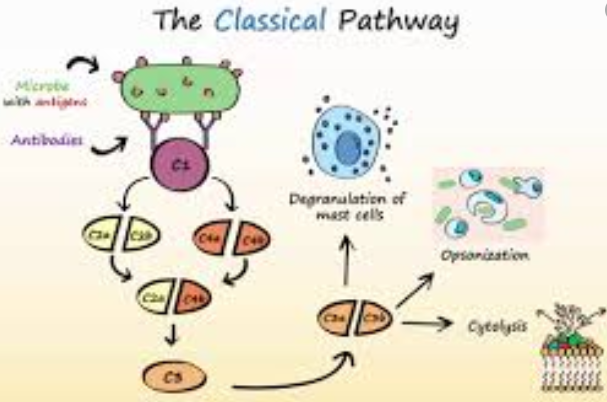An Overview of the Relationship Between Complement System and Autoimmune Diseases (II)

An Overview of the Relationship Between Complement System and Autoimmune Diseases (II)
3.3 Dermatomyositis
Inflammatory myopathy is a group of acquired diseases characterized by inflammatory cell infiltration of skeletal muscle and muscle fiber necrosis, usually manifested as moderate to severe muscle weakness and infection, mainly including polymyositis, dermatomyositis and inclusion bodies. Dermatomyositis (DM) is a type of microvascular disease regulated by complement, which mainly affects the skin and muscles. The activation and deposition of complement can cause endocardial capillary rupture, resulting in muscle ischemia. The cleaved vascular endothelium serves as the main target antigen and can trigger antibody production. The antibody directly binds to endothelial cells, thereby activating C3. Activated C3 further produces C3b and C4b fragments, which ultimately leads to the formation of MAC. Complement deposition will continue to cause endothelial cell enlargement and vacuolization, eventually leading to ischemia and muscle fiber destruction.
3.4 Anti-neutrophil cytoplasmic antibody (ANCA)-associated vasculitis
Anti-neutrophil cytoplasmic antibody (ANCA)-associated vasculitis (AAV) mainly includes cryoglobulinemia vasculitis and allergic purpura nephritis. The former is due to excessive complement consumption, patients usually have hypocomplementemia, manifested by low concentrations of C4 and Clq in the serum, C3 and Clq can be detected in the tissue. The latter usually has IgA deposition, and at the same time on the glomerular C3 deposition similar to IgA nephritis occurs. It is currently believed that IgA deposition in allergic purpura nephritis and IgA nephritis is related to the deposition of complement factors, mainly C3, P factor and MAC.
3.5 Anti-glomerular basement membrane disease
Anti-glomerular basement membrane disease refers to a group of autoimmune diseases caused by the deposition of circulating anti-glomerular basement membrane antibodies in the organs. The disease is caused by IgG autoantibodies attacking the glomerular basement membrane (GBM), at the same time, because the alveolar basement membrane and GBM have a certain homology in structure, it can involve the lungs and lead to pulmonary hemorrhage-nephritis syndrome. The disease is one of the few autoimmune diseases for which antigens have been identified so far, and pathogenic antigens can cause the production of anti-IgG autoantibodies. After the antigen and antibody are combined, they can produce autoimmune reactions, such as strong complement activation, leukocyte infiltration and proteinuria, which will eventually lead to the formation of crescents and scars, leading to the decline of kidney function.
3.6 Antiphospholipid syndrome
Antiphospholipid syndrome (APS) is a group of clinical signs of thrombosis, habitual abortion, thrombocytopenia, and neuropsychiatric system damage caused by antiphospholipid antibodies (APL antibodies). APL antibody can react with a variety of antigenic substances containing phospholipid structure include lupus anticoagulant, anticardiolipin antibodies, antiphosphatidic acid antibodies and antiphosphatidylserine antibodies. Complement activation plays a key role in miscarriage and fetal growth retardation in APS patients. The levels of C3 and C4 in the serum of early APS patients are low, but the levels of C3a and C4a are higher than normal people, indicating that the hypocomplementemia in APS patients is caused by complement activation rather than complement defects.
3.7 Systemic sclerosis
Systemic sclerosis (SSc) is a type of connective tissue disease characterized by thickening of the skin and visceral fibrosis, which can affect the peripheral parts and the face (limitation), or the proximal extremities and trunk (diffuse). Studies have shown that there is no complement deposition in SSc patients. However, there is immune complex deposition in endothelial cells, accompanied by abnormal complement activation. The study found that the plasma C3d levels, C3d / C3 and Ba / B factor ratios of patients with diffuse SSc were higher than normal people, and C3d, C3d / C3, C4d, C4d / C4 of patients with restrictive SSc were higher than normal people, which suggests that SSc may be via the classical pathway activation, its level can be used as an indicator of clinical detection of disease.

3.8 Other autoimmune diseases
Recent studies have found that complement is also closely related to many other types of autoimmune diseases, such as Sjögren's syndrome, autoimmune hepatitis, and nervous system diseases. The relevant pathogenic mechanisms need to be further elucidated.
Summary
The complement system plays an important regulatory role in the pathogenesis of autoimmune diseases. The development and synthesis of complement-related preparations with good therapeutic effects through immunological methods is one of the treatment methods for autoimmune diseases. Currently, there are C3aR, C5aR antagonists, Anti-C5 monoclonal antibody, soluble CRI and other drugs have achieved good results in clinical trials. At the same time, the establishment of an animal model of complement deficiency to study the regulation of the complement system will also provide new methods and ideas for the prevention and treatment of autoimmune diseases, and provide theoretical and practical guidance for further clarifying the relationship between complement and autoimmune diseases.
With more than a decade of exploration and development, Creative Biolabs offers a full range of one-stop services for Complement Therapeutics. In addition, the company’s project procedure can be totally designed to meet different special requirements.